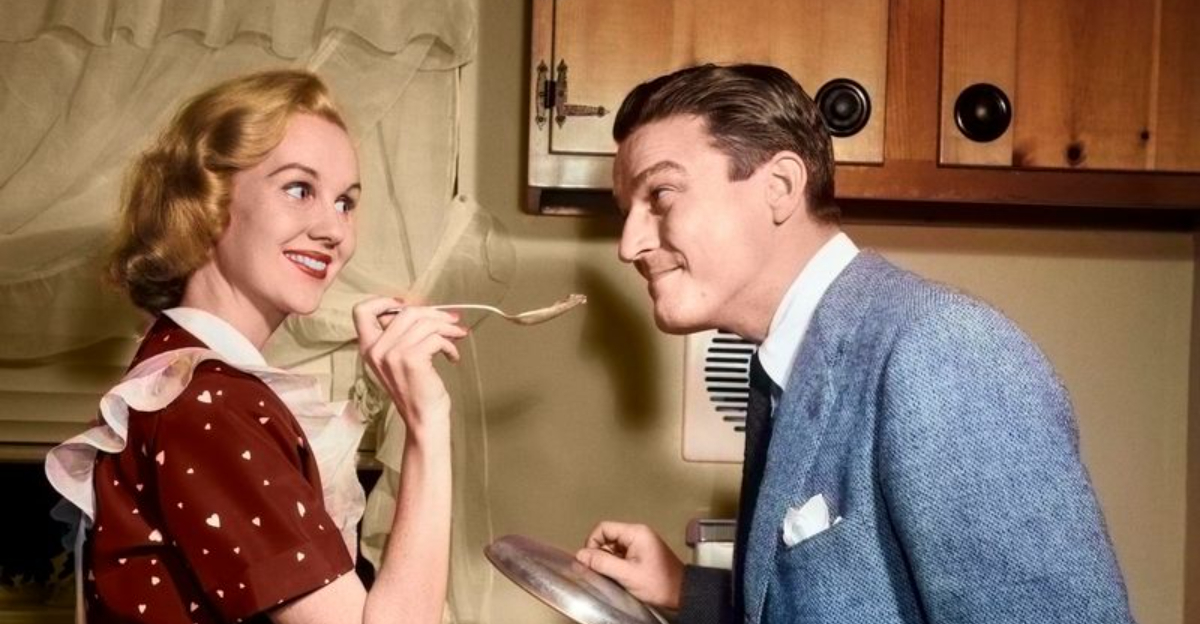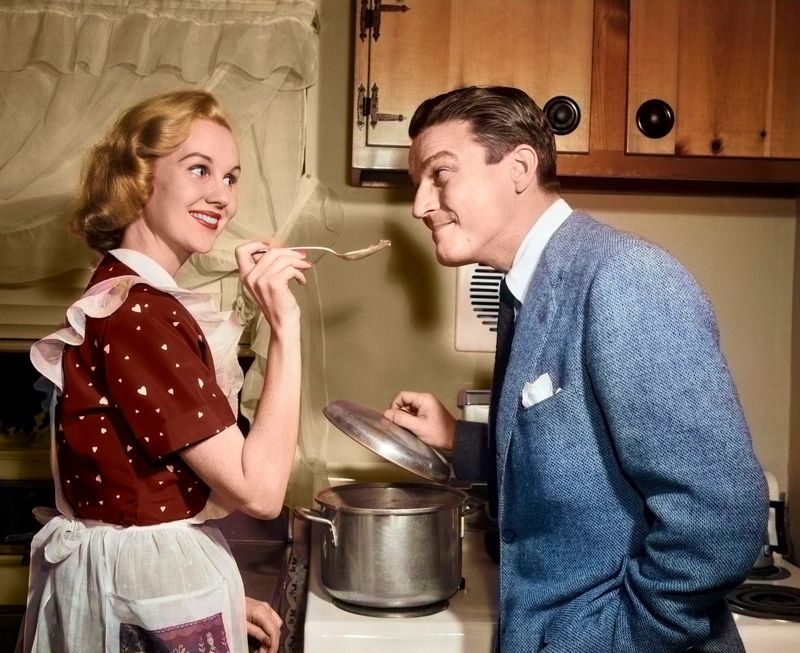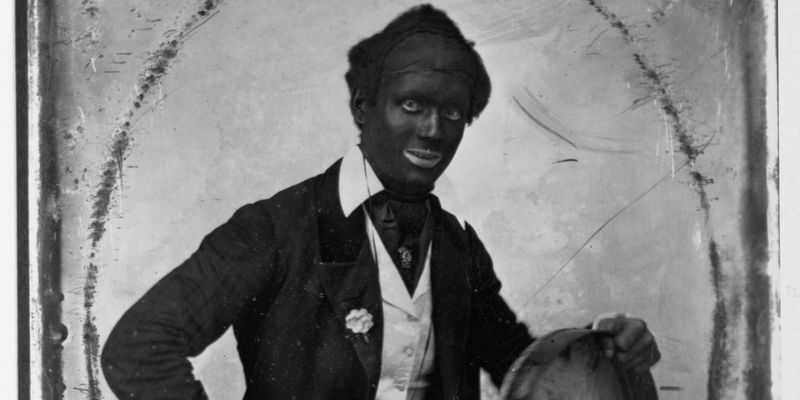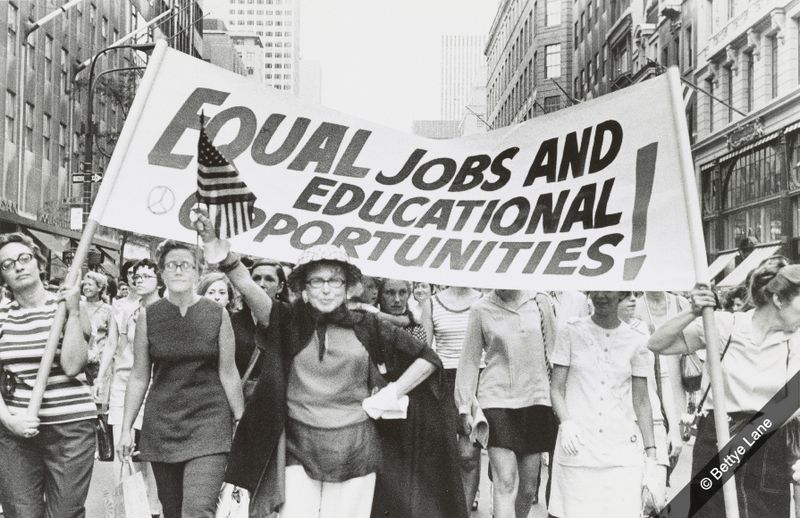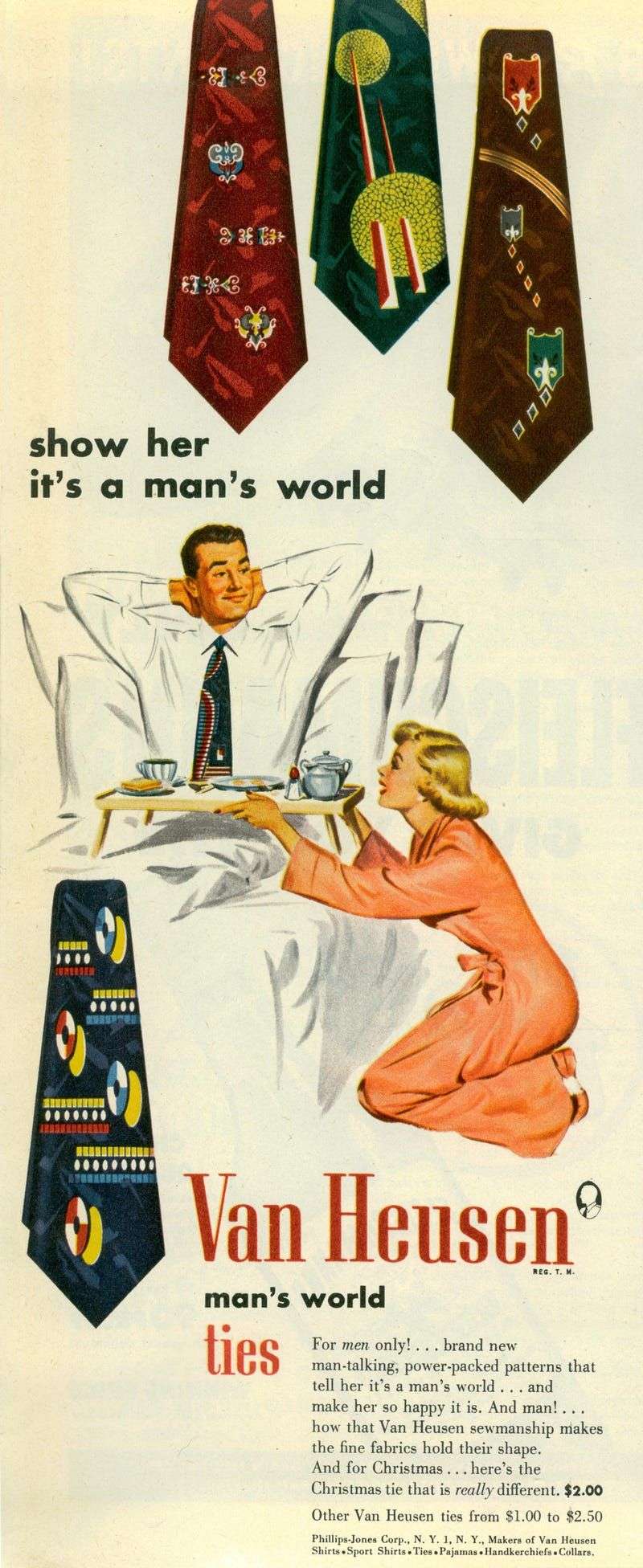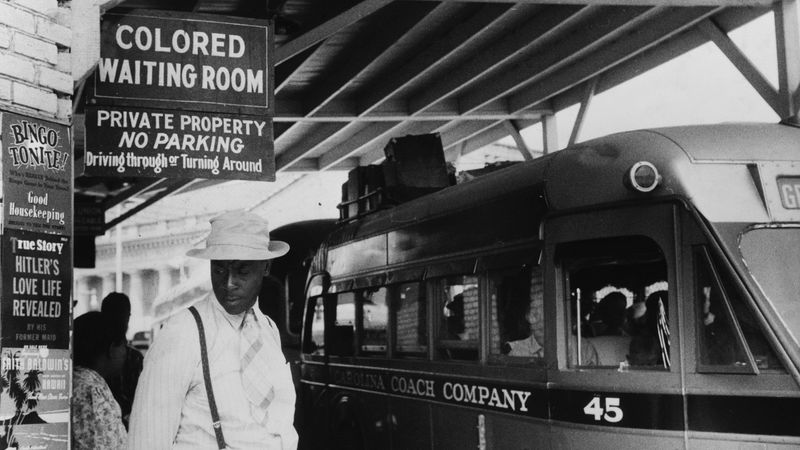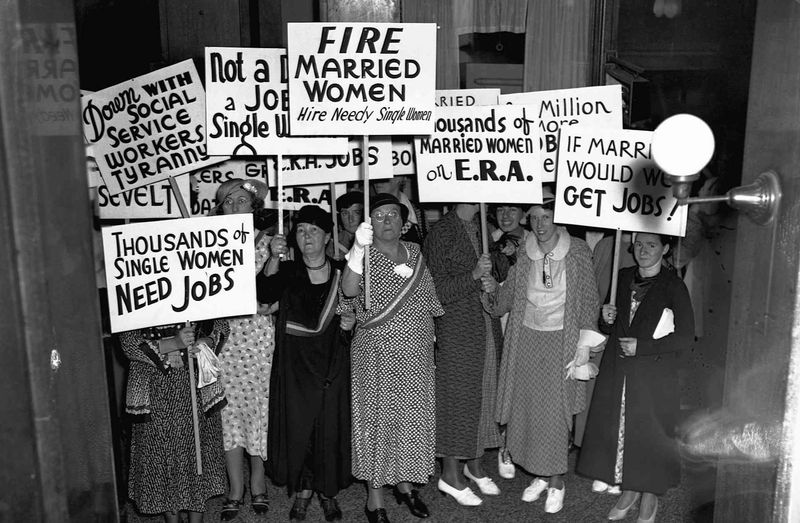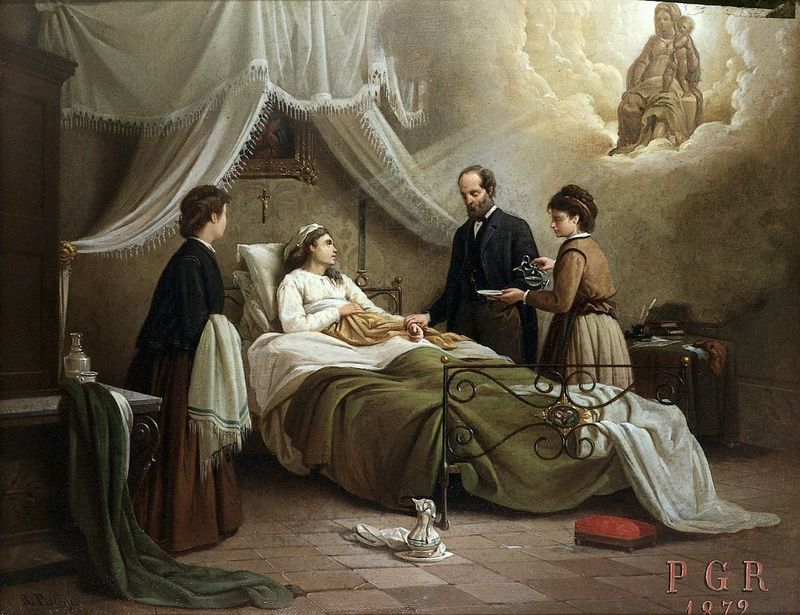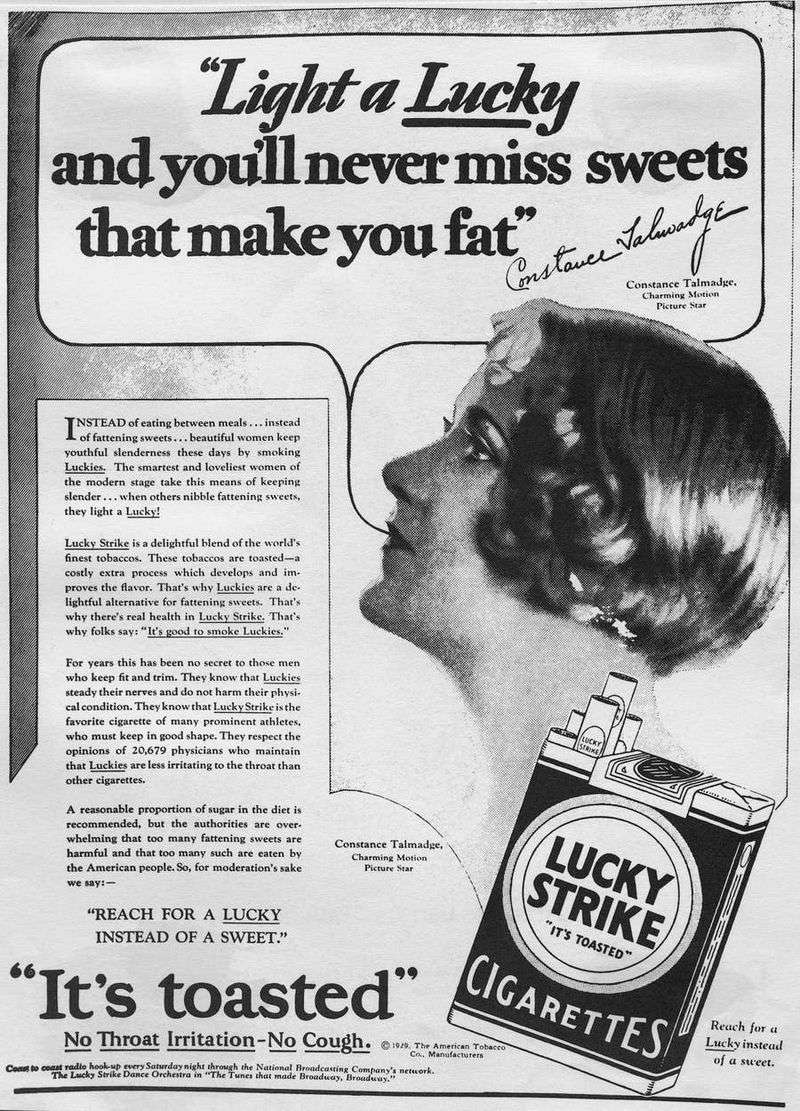The 1940s were a time when social norms and expectations for men were dramatically different than they are today. World War II was reshaping society, but many traditional behaviors remained firmly in place. Looking back, many common male practices from this era now seem not just old-fashioned but downright offensive by modern standards. The following behaviors were once considered normal or even proper for men, but would likely result in serious consequences today.
1. Call Women ‘Honey’ or ‘Sweetheart’ at Work
Men casually addressed female colleagues with pet names like “honey,” “sweetheart,” or “doll” regardless of professional status. A male boss might summon his secretary with “Sweetheart, bring me those files,” and it was considered perfectly normal.
Women were expected to smile and accept these diminutive terms without complaint. Many workplace relationships were built on this power dynamic that reduced women to childlike status.
Today, such language constitutes workplace harassment and creates a hostile environment. Modern professional settings demand respectful communication where colleagues address each other by name or appropriate title.
2. Expect Wives to Have Dinner Ready Every Night
Walking through the door at 6 PM sharp, men expected to find a hot, home-cooked meal waiting regardless of their wife’s day. Women’s magazines published helpful schedules showing wives how to time their entire day around husband-pleasing meal preparation.
Failure to provide dinner on time was considered a serious wifely shortcoming. No excuses were acceptable—not illness, crying children, or any household emergency.
Contemporary relationships recognize that meal preparation is a shared responsibility. Modern couples discuss who cooks based on schedules, preferences, and abilities rather than gender-assigned roles.
3. Refuse to Take No for an Answer on Dates
Romantic persistence was glorified in 1940s culture. Men were taught that women’s rejections weren’t genuine—just tests of their determination and masculinity. Popular films showed heroes wearing down reluctant women through relentless pursuit.
Dating advice columns encouraged men to ignore initial refusals. “She’s just playing hard to get” was standard wisdom, and women who meant their “no” were labeled frigid or stuck-up.
Today we recognize this behavior as harassment or stalking. Consent culture emphasizes that rejection must be respected immediately, and persistence after refusal is inappropriate and potentially criminal.
4. Smoke in Hospitals and Public Buildings
Doctors puffed cigarettes while discussing diagnoses. Fathers celebrated new babies by handing out cigars and smoking them in maternity wards. Ashtrays adorned hospital bedside tables as standard equipment.
Men smoked during business meetings, on buses, in elevators, and even in school buildings. The haze of tobacco smoke was considered a normal part of indoor air quality, and complaining about it would mark someone as overly sensitive.
Scientific understanding of secondhand smoke dangers has transformed this behavior into a public health violation. Modern smoking bans protect everyone’s right to clean air in shared spaces.
5. Perform in Blackface for Entertainment
White men regularly darkened their faces with burnt cork or shoe polish for “comedy” performances at community events, military shows, and professional entertainment. This practice extended from minstrel shows into mainstream radio programs, films, and even corporate parties.
These caricatures reinforced deeply harmful stereotypes while appropriating and mocking Black culture. Audiences laughed without questioning the devastating social impact.
Today, blackface is recognized as a profoundly racist practice rooted in white supremacy. Historical examples continue to resurface, forcing public figures to apologize for past participation in what is now understood as hate-based entertainment.
6. Dismiss Women from Serious Professions
Despite women’s crucial wartime contributions, men openly questioned female capabilities in medicine, law, engineering, and business. A woman doctor might be tolerated as a pediatrician but not as a surgeon, while female attorneys were steered toward family law rather than corporate litigation.
Men routinely explained basic concepts to qualified female professionals. Workplace manuals explicitly stated that women lacked the emotional stability for leadership positions.
Modern workplaces recognize that competence isn’t gender-specific. Professions previously dominated by men now benefit from diverse perspectives, with research confirming that gender-balanced teams produce superior results across industries.
7. Mock Men Who Helped with Housework
A husband who washed dishes risked ridicule from male friends and neighbors. Men who participated in traditionally female tasks were labeled “henpecked” or questioned about their masculinity. Magazine cartoons regularly mocked men wearing aprons.
Fathers might play with children but weren’t expected to change diapers, prepare meals, or handle bedtime routines. These tasks were deemed emasculating and inappropriate for male dignity.
Contemporary partnerships recognize that household management requires everyone’s contribution. Modern men take pride in cooking skills and childcare abilities, with studies showing that involved fathers benefit children’s development while strengthening family bonds.
8. Use Racial Slurs in Everyday Conversation
Casual racism permeated daily language in the 1940s. Men used derogatory terms for various ethnic groups without hesitation in workplaces, social clubs, and family dinner tables. Newspapers and radio broadcasts contained language that would be unthinkable in today’s media.
Children were taught these terms as if they were neutral descriptors. Neighborhoods, businesses, and even food items carried names we now recognize as deeply offensive.
Modern society acknowledges the violence inherent in such language. We understand that words shape perceptions and that respectful communication forms the foundation for a more equitable society where all people are treated with basic dignity.
9. Exclude Women from Financial Decisions
Banking was considered men’s territory. Women needed husband’s permission to open accounts, and married women’s credit applications required male co-signers regardless of their own income. Mortgage interviews included only husbands, even when wives contributed financially.
Men handled investment decisions unilaterally. Financial advisors directed all information to husbands, ignoring wives present in meetings.
Today’s financial institutions recognize women’s economic autonomy. Studies show women often make more conservative, successful investors than men, and family financial decisions benefit from diverse perspectives and priorities that consider everyone’s needs.
10. Drink Heavily at Work Functions
Three-martini lunches were standard business practice. Men conducted important negotiations over multiple rounds of drinks, and staying sober while colleagues indulged was considered unsociable or even suspicious.
Office parties featured open bars with unlimited consumption. Driving home intoxicated afterward was common and rarely penalized, despite obvious dangers.
Contemporary workplace culture recognizes alcohol’s negative impact on judgment and productivity. Modern companies limit alcohol at functions, provide transportation alternatives, and no longer expect drinking as a professional obligation. Workplace sobriety is respected rather than questioned.
11. Judge Women Primarily on Appearance
Beauty pageants were considered legitimate career paths for women. Companies openly hired based on looks, with job advertisements specifying “attractive girls only” or requesting photographs with applications for secretarial positions.
Men freely commented on female colleagues’ bodies during performance reviews. Women’s magazines emphasized that maintaining physical attractiveness was essential to job security regardless of competence.
Modern workplace standards recognize appearance-based discrimination as both harmful and counterproductive. Professional evaluations now focus on measurable skills and achievements rather than subjective physical attributes, creating environments where diverse talent can thrive.
12. Force Wives to Quit Jobs After Marriage
Marriage bans were formal policies prohibiting married women from continued employment. Upon engagement announcement, female employees received congratulations followed by termination notices. A husband’s income was considered the family’s only legitimate financial support.
Banks, schools, and government offices explicitly fired women who married. Those who wanted careers had to choose between professional fulfillment and family life.
Today’s dual-income households represent the norm rather than the exception. Career continuity through life changes is protected by law, and marriage is no longer grounds for termination in any professional context.
13. Never Change Diapers or Handle Childcare
Fathers proudly proclaimed never having changed a single diaper despite raising multiple children. Men’s restrooms lacked changing tables, making childcare physically impossible in public spaces even for willing fathers.
Men who showed too much interest in childcare faced suspicion. Parenting books addressed only mothers, and fathers who attended pediatrician visits were asked, “Is Mom sick today?”
Contemporary fatherhood embraces hands-on parenting. Modern dads advocate for changing stations in men’s rooms and take paternity leave to bond with newborns, recognizing that children benefit from involved caregiving from all parents.
14. Make Medical Decisions for Women Without Consent
Doctors routinely discussed women’s health with husbands instead of patients themselves. Major medical decisions—including sterilization procedures—were made with male approval but without female knowledge or consent.
Women were deliberately kept uninformed about their own bodies. Medical paternalism assumed that women couldn’t understand or handle health information, leading to treatments being performed without explanation.
Patient autonomy now forms the cornerstone of medical ethics. Modern healthcare recognizes every adult’s right to informed consent regardless of gender, and medical information belongs primarily to the patient rather than their family members.
15. Openly Criticize Women’s Weight and Eating
Men freely commented on women’s bodies at dinner tables, social gatherings, and workplaces. “Watch those calories, honey” was considered helpful advice rather than harmful commentary. Women’s magazines featured husband-pleasing diet tips to maintain the figure he married.
Weight gain after childbirth received particular scrutiny. Food consumption became public domain for commentary, with men monitoring their wives’ plates at restaurants and family meals.
Contemporary understanding recognizes the psychological damage of body criticism. Modern relationships acknowledge that personal health choices belong to individuals, and commenting on others’ bodies—regardless of intention—creates lasting harm to self-image and relationship trust.
